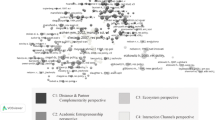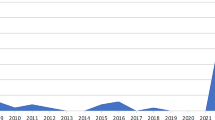Abstract
Information systems permeate every business function, thereby requiring holistic Information Systems (IS) approaches. Much academic research is still discipline specific. More interdisciplinary research is needed to inform both industry and academe. Interdisciplinary research has been positively associated with increased levels of innovation, productivity and impact. IS research contributes to the knowledge creation and innovation within IS and other College of Business (COB) disciplines. This research defines the intellectual structures within IS and between IS and other COB disciplines. We use a large scale, diachronic bibliometric analysis of COB journals to assess reciprocal knowledge exchange and also to identify potential intra- and interdisciplinary publication outlets. Our findings show an increase in IS knowledge contributions to other COB disciplines, which supports the discussion that IS is a reference discipline. Our research also visually depicts the intellectual structures within IS and between IS and other COB disciplines. Anyone exploring research in IS and allied COB disciplines can peruse the proximity maps to identify groups of similar journals. The findings from this research inform decisions related to which journals to read, target as publication outlets, and include on promotion and tenure lists.






Similar content being viewed by others
References
Acedo, F. J., et al. (2006). Co-authorship in management and organizational studies: An empirical and network analysis. Journal of Management Studies, 43(5), 957–983.
Anonymous. (2007). Practically irrelevant? What is the point of research carried out in business schools? Retrieved June 17, 2011 from http://www.economist.com/node/9707498.
Balsiger, P. W. (2004). Supradisciplinary research practices: History, objectives and rationale. Futures, 36(4), 407–421.
Baskerville, R. L., & Myers, M. D. (2002). Information systems as a reference discipline. MIS Quarterly, 26(1), 1–14.
Baskerville, R. L., & Myers, M. D. (2009). Fashion waves in information systems research and practice. MIS Quarterly, 33(4), 647–662.
Biehl, M., Kim, H., & Wade, M. (2006). Relationships among the academic business disciplines: A multi-method citation analysis. Omega, 34(4), 359–371.
Borg, I., & Lingoes, J. C. (1987). Multidimensional similarity structure analysis. London: Springer-Verlag.
Borrego, M., & Newswander, L. (2008). Analysis of interdisciplinary faculty job postings by institutional type, rank, and discipline. The Journal of the Professoriate, 5(2), 1–31.
Chait, R. P. (Ed.) (2002). The questions of tenure. Cambridge, MA: Harvard University Press.
Chan, H. C., Kim, H. W., & Tan, W. C. (2006). Information systems citation patterns from international conference on information systems articles. Journal of the American Society for Information Science and Technology, 57(9), 1263–1274.
Chua, C., et al. (2002). Measuring researcher production in information systems. Journal of the Association for Information Systems, 3(6), 145–215.
Culnan, M. J., & Swanson, E. B. (1986). Research in management information systems 1980–1984: Points of work and reference. MIS Quarterly, 10(3), 289–302.
Dennis, A. R., et al. (2006). Research standards for promotion and tenure in information systems. MIS Quarterly, 30(1), 1–12.
De Bellis, N. (2009). Bibliometrics and citation analysis. Toronto: The Scarecrow Press Inc.
Di Meglio, F. (2007). New role for business school research. Bloomberg Businessweek. Retrieved February 19, 2012 from http://www.businessweek.com/bschools/content/aug2007/bs20070814_496957.htm.
De Solla Price, D. J. & Beaver, D. B. (1996). Collaboration in an invisible college. American Psychologist, 21(11), 1011–1018.
Gill, G., & Bhattacherjee, A. (2009). Whom are we informing? Issues and recommendations for MIS research from an informing sciences perspective. MIS Quarterly, 33(2), 217–235.
Grover, V., et al. (2006a). A citation analysis of the evolution and state of information systems within a constellation of reference disciplines. Journal of the Association for Information Systems, 7(5), 270–324.
Grover, V., et al. (2006b). About reference disciplines and reference differences: A critique of Wade et al. Journal of the Association for Information Systems, 7(5), 336–349.
Grover, V., Straub, D., & Galluch, P. (2009). Turning the corner: The influence of positive thinking on the information systems field. MIS Quarterly, 1(33), III–VIII.
Hardgrave, B. C., & Walstrom, K. A. (1997). Forums for MIS scholars. Communications of the ACM, 40(11), 119–124.
Katerattanakul, P., et al. (2005). Consistency and concern on IS journal rankings. Journal of Information Technology Theory and Application, 7(2), 1–20.
Klein, J. T. (1996). Crossing boundaries: Knowledge, disciplinarities, and interdisciplinarities. Charlottesville, VA: University of Virginia Press.
Kozar, K. A., Larsen, K. R., & Straub, D. (2006). Leveling the playing field: A comparative analysis of business school journal productivity. Communications of the AIS, (17) Article 23, 27.
Kruskal, J. B., & Wish, M. (1978). Multidimensional scaling. London: Sage.
Laband, D., & Tollison, R. (2000). Intellectual collaboration. Journal of Politicial Economy, 108(3), 632–662.
Lariviere, V., & Gingras, Y. (2009). On the relationship between interdisciplinarity and scientific impact. Journal of the American Society for Information Science and Technology, 61(1), 126–131.
Levine-Clark, M., & Gil, E. (2009). A comparative analysis of social sciences citation tools. Online Information Review, 33(5), 986–996.
Levitt, J. M., & Thelwall, M. (2008). Is multidisciplinary research more highly cited? A macrolevel study. Journal of the American Society for Information Science and Technology, 59(12), 1973–1984.
Leydesdorff, L., & Vaughan, L. (2006). Co-occurrence matrices and their applications in information science: Extending ACA to the web environment. Journal of the American Society for Information Science and Technology, 57(12), 1616–1628.
Lim, A., et al. (2009). Distinguishing citation quality for journal impact assessment. Communications of the ACM, 52(8), 111–116.
McCain, K. W. (1990). Mapping authors in intellectual space: A technical overview. Journal of the American Society for Information Science, 41(6), 433–443.
McCain, K. W. (1991). Mapping economics through the journal literature: An experiment in journal cocitation analysis. Journal of the American Society for Information Science, 42(4), 290–296.
McCormack, K. P., & Johnson, W. C. (2001). Business process orientation: gaining the e-business competitive advantage. Boca Raton, FL: St. Lucie Press.
Meho, L. I., & Sonnenwald, D. H. (2000). Citation ranking versus peer evaluation of senior faculty research performance: A case study of Kurdish scholarship. Journal of the American Society for Information Science, 51(2), 123–138.
Meho, L. I., & Sugimoto, C. R. (2009). Assessing the scholarly impact of information studies: A tale of two citation databases-Scopus and Web of Science. Journal of the American Society for Information Science and Technology, 60(12), 2499–2508.
Myers, M. D., & Baskerville, R. L. (2009). Commentary on Gill and Bhattacherjee: Is there an informing crisis? MIS Quarterly, 33(4), 663–665.
Mylonopoulos, N. A., & Theoharakis, V. T. (2001). Global perceptions of IS journals–Where is the best IS research published? Communications of the ACM, 44(9), 29–33.
National Academies Report (2004). Facilitating interdisciplinary research. N. A. Report, National Academies Press: Washington, DC.
Nerur, S., et al. (2005). Assessing the relative influence of journals in a citation network. Communications of the ACM, 48(11), 71–74.
Oh, W., Choi, J. N., & Kim, K. (2005). Coauthorship dynamics and knowledge capital: the patterns of cross-disciplinary collaboration in information systems research. Journal of Management Information Systems, 22(3), 265–292.
Peffers, K., & Tang, Y. (2003). Identifying and evaluating the universe of outlets for information systems research: Ranking the journals. Journal of Information Technology Theory and Application, 5(1), 63–84.
Pfeffer, J. (2007). A modest proposal: How we might change the process and product of managerial research. Academy of Management Journal, 50(6), 1334–1345.
Polites, G. L., & Watson, R. T. (2009). Using social network analysis to analyze relationships among IS journals. Journal of the Association for Information Systems, 10(8), 595–636.
Pollack, M. E. & Snir, M. (2008). Best practices memo: Promotion and tenure of interdisciplinary faculty. Retrieved August 17, 2010, from http://www.cra.org/resources/bp-view/best_practices_memo_promotion_and_tenure_of_interdisciplinary_faculty/.
Presser, S. (1980). Collaboration and the quality of research. Social Studies of Science, 10(1), 95–101.
Rainer, R. K., & Miller, M. D. (2005). Examining differences across journal rankings. Communications of the ACM, 48(2), 91–94.
Skrinjar, R., Vosilj-Vuksic, V., & Indihar-Stemberger, M. (2008). The impact of business process orientation on financial and non-financial performance. Business Process Management Journal, 14(5), 738–754.
Small, H. (1973). Co-citation in the scientific literature: A new measure of the relationship between two documents. Journal of the American Society for Information Science, 24(4), 265–269.
Stevens, J. (1996). Applied multivariate statistics for the social science. Mahwah: Lawrence Erlbaum Associates.
Sugimoto, C. R., Pratt, J. A., & Hauser, K. (2008). Using field cocitation analysis to assess reciprocal and shared impact of LIS/MIS fields. Journal of the American Society for Information Science and Technology, 59(9), 1441–1453.
Taneja, A., Singh, A., & Raja, M. K. (2009). Computing journals and their emerging roles in knowledge exchange. Communications of the ACM, 52(11), 125–131.
Taylor, H., Dillon, S., & Van Winger, M. (2010). Focus and diversity in information systems research: Meeting the dual demands of a healthy applied discipline. MIS Quarterly, 34(4), A621–A647.
Valacich, J. S., et al. (2006). Issues and opinions–Publication opportunities in premier business outlets: How level is the playing field? Information Systems Research, 17(2), 107–125.
Wade, M., Biehl, M., & Kim, H. (2006a). Information Systems is not a reference discipline (and what we can do about it). Journal of the Association for Information Systems, 7(5), 247–268.
Wade, M., Biehl, M., & Kim, H. (2006b). If the tree of IS knowledge falls in a forest, will anyone hear?: A commentary on Grover et al. Journal of the Association for Information Systems, 7(5), 326–334.
Walstrom, K. A., Hardgrave, B. C., & Wilson, R. L. (1995). Forums for management information systems scholars. Communications of the ACM, 38(3), 93–107.
White, H. D. (2003). Pathfinder networks and author cocitation analysis: A remapping of paradigmatic information scientists. Journal of the American Society for Information Science and Technology, 54(5), 423–434.
White, H. D., & Griffith, B. C. (1981). Author cocitation: A literature measure of intellectual structure. Journal of the American Society for Information Science, 32(3), 163–171.
Willcocks, L., Whitley, E. A., & Avgerou, C. (2008). The ranking of top IS journals: A perspective from the London School of Economics. European Journal of Information Systems, 17(2), 163–168.
Author information
Authors and Affiliations
Corresponding author
Electronic supplementary material
Below is the link to the electronic supplementary material.
Rights and permissions
About this article
Cite this article
Pratt, J.A., Hauser, K. & Sugimoto, C.R. Defining the intellectual structure of information systems and related college of business disciplines: a bibliometric analysis. Scientometrics 93, 279–304 (2012). https://doi.org/10.1007/s11192-012-0668-y
Received:
Published:
Issue Date:
DOI: https://doi.org/10.1007/s11192-012-0668-y




